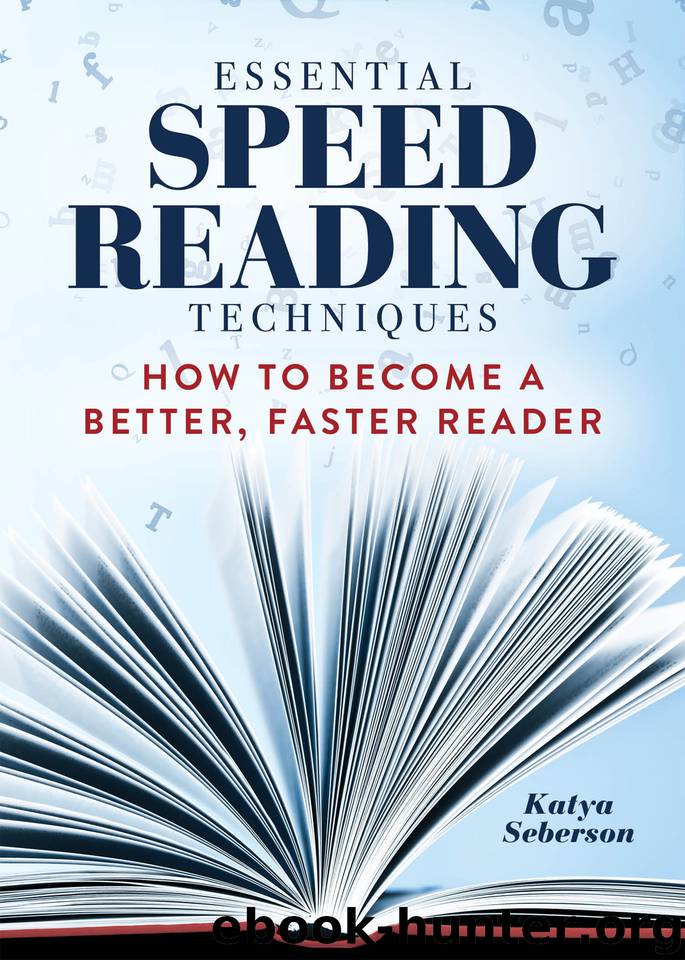Essential Speed Reading Techniques: How to Become a Better, Faster Reader by Katya Seberson

Author:Katya Seberson [Seberson, Katya]
Language: eng
Format: azw3
Publisher: Rockridge Press
Published: 2019-08-12T16:00:00+00:00
• Learn to encourage yourself. We need to practice this regularly. When you falter, can you be encouraging to yourself? Can you stay positive in the face of failure? Can you look at it as another step in your growth, instead of failure?
• Find encouragement from others. In the same way, we can get encouragement from other people. Ask for help from friends and family. Find a good friend who will help you get back on track, with love. We are not alone—lots of others know what it’s like to struggle, and are willing to support us when we’re struggling.
• Learn perseverance—keep coming back. Stay positive when things go astray, and just keep coming back to the habit you want to change. Want to quit smoking but you backtracked when your father died? Get back on it as soon as you’re able. Come back with even more resolve. Commit yourself even deeper.
Can you feel that if you practice these skills, you’ll handle any difficulty that comes your way? That your path to change might be bumpy, filled with obstacles, but nothing will stop you if you keep a positive attitude, keep coming back, keep being loving and compassionate with yourself?
This is habit resilience. And it will change your entire life, if you practice.
Stop Reading!
Now let’s do a quick comprehension test. Please write a couple of sentences summarizing the article. What is habit resilience, and how do you develop it?
Answer Key
Your paragraph should look something like this:
Habit resilience is the ability to bounce back when things don’t go as planned; it’s the main differentiating factor between people who change habits and those who don’t. To develop habit resilience, learn to face problems instead of pretending they don’t exist, learn to adjust, feel self-compassion, and learn to encourage yourself and recommit in the face of adversity.
If you were able to maintain a slightly higher speed and your summary matches the answer key, we encourage you to take your practice to your own reading material. Make sure you have at least 20 minutes of uninterrupted time to enjoy your book and train yourself to reduce subvocalization and reinforce clustering. Try to read 15 to 25 percent faster with full comprehension. If you normally read four pages in five minutes, go for five pages in five minutes for your practice. We encourage you to give subvocalization 15 to 30 practice sessions of 20 minutes or more. In those sessions, you want to teach your brain to break the barrier of spoken word and maintain comprehension without inner speech.
If you didn’t make the time or misunderstood the text when you read faster, turn the dial back and slowly increase your speed. In your book, if you usually read four pages in five minutes, try to read four and a half pages in five minutes for your practice. There is no rush in retraining your brain; let it adjust to the new speed. Boost your pace once you start to feel more comfortable at a faster rate and keep adding.
Download
This site does not store any files on its server. We only index and link to content provided by other sites. Please contact the content providers to delete copyright contents if any and email us, we'll remove relevant links or contents immediately.
| Arts & Humanities | Health |
| Language Arts | Library Skills |
| Mathematics | Reading & Phonics |
| Science & Technology | Social Studies |
The Art of Coaching Workbook by Elena Aguilar(49127)
Trainspotting by Irvine Welsh(20471)
Twilight of the Idols With the Antichrist and Ecce Homo by Friedrich Nietzsche(17922)
Fangirl by Rainbow Rowell(8148)
Periodization Training for Sports by Tudor Bompa(7556)
Change Your Questions, Change Your Life by Marilee Adams(6904)
This Is How You Lose Her by Junot Diaz(6064)
Grit by Angela Duckworth(4959)
Red Sparrow by Jason Matthews(4880)
Asking the Right Questions: A Guide to Critical Thinking by M. Neil Browne & Stuart M. Keeley(4864)
Paper Towns by Green John(4405)
Room 212 by Kate Stewart(4323)
Ken Follett - World without end by Ken Follett(4149)
The Sports Rules Book by Human Kinetics(3771)
Housekeeping by Marilynne Robinson(3675)
The Motorcycle Diaries by Ernesto Che Guevara(3519)
Papillon (English) by Henri Charrière(3504)
Exercise Technique Manual for Resistance Training by National Strength & Conditioning Association(3477)
Double Down (Diary of a Wimpy Kid Book 11) by Jeff Kinney(3468)
